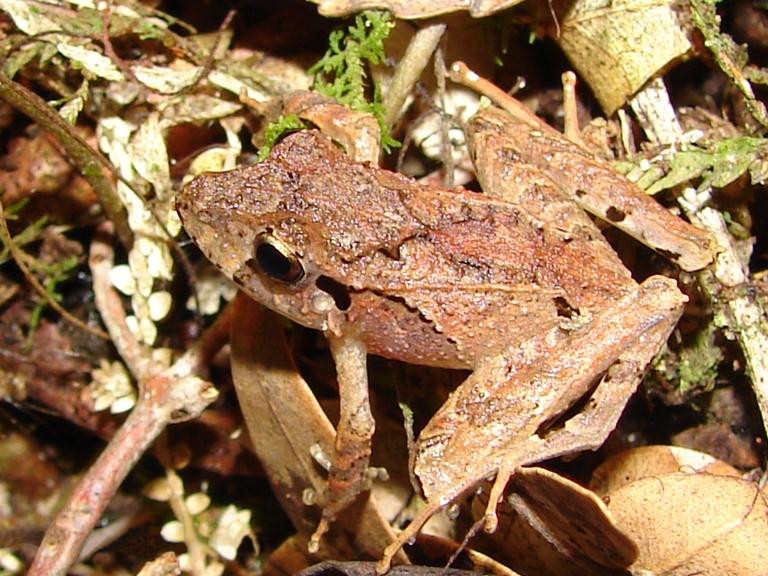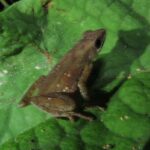- Introduction: Discovering Ischnocnema henselii—A Voice in the Forest Night
- Taxonomy and Classification of Ischnocnema henselii
- Natural Habitat: In the Heart of Brazil’s Atlantic Rainforest
- Physical Characteristics: A Secretive Beauty in Subtle Camouflage
- Behavior and Life Cycle: The Secret Lives Beneath the Canopy
- The Ecological Role: Guardians of Balance
- Conservation Status and Threats: Saving the Individuals, Preserving the Forests
- Cultural and Scientific Significance
- Conclusion: Why Ischnocnema henselii Matters and What We Must Do
Introduction: Discovering Ischnocnema henselii—A Voice in the Forest Night#
Imagine yourself trekking through the verdant depths of Brazil’s enchanting Atlantic Rainforest. As twilight melts gently into the warm embrace of night, a symphony of calls greets you—the rhythmic chirps of insects, the whispers of wind through the ancient trees, and amid this chorus, subtle yet distinct, the clear, musical note of a small frog known scientifically as Ischnocnema henselii. Known to herpetologists and local communities, this modest yet intriguing amphibian has captivated researchers and nature enthusiasts alike with its cryptic nature and delicate beauty.
Belonging to a somewhat lesser-known genus called Ischnocnema, I. henselii embodies the extraordinary diversity and ecological complexity characteristic of Brazil’s Atlantic Forest—one of the most biodiverse yet endangered ecosystems on Earth. Far from being just an obscure amphibian, I. henselii serves as a perfect ambassador, quietly inviting us to explore deeper into the heart of the rainforest and to appreciate the many species whose survival closely intertwines with our collective choices.
Taxonomy and Classification of Ischnocnema henselii#
Before embarking on the exploration of this mesmerizing frog’s life and habitat, it’s important to understand its taxonomic heritage. Ischnocnema henselii belongs to the family Brachycephalidae, a fascinating lineage of frogs endemic to South America—especially prominent in Brazilian forests. Within the genus Ischnocnema, it occupies a special niche due to its unique anatomical and ecological characteristics.
The species name, henselii, honors the German-born naturalist Reinhold Friedrich Hensel, who first documented and brought many intriguing specimens from Brazil before the eyes of European scientists in the late nineteenth century. Ever since its official description in 1870, this humble creature has inspired more than a century of herpetological studies, debates, and expeditions.
Closely related to other small terrestrial frogs in its family, such as those within the genera Brachycephalus and Euparkerella, I. henselii demonstrates remarkable adaptations suited to the dense and humid subtropical environment from where it hails.
Natural Habitat: In the Heart of Brazil’s Atlantic Rainforest#
Geographic Range and Distribution#
Ischnocnema henselii is predominantly found in southeastern Brazil, in regions characterized by rich, subtropical to tropical moist forest ecosystems. Specifically, its populations flourish notably within the Atlantic Rainforest biome, a delicate and biodiverse ecosystem blanketing Brazil’s coastal ranges. While their presence is concentrated primarily within the states of São Paulo, Rio de Janeiro, Espírito Santo, Paraná, and parts of Rio Grande do Sul, isolated populations might persist within neighboring territories as a consequence of ancient habitat continuity.
The Forest Floor: Microhabitat Preferences#
Crucially intertwined with the health of its environment, I. henselii thrives within the leaf-littered habitats that carpet the rainforest floor. Shaded by towering trees draped in climbing lianas and ferns, the ground-level ecosystem provides ideal conditions—humid, cool, rich in organic matter, and teeming with the small arthropods abundant enough to sustain healthy populations.
Within the intricate mosaic of forest habitats, this small frog demonstrates a keen preference for areas with dense leaf litter, decaying logs, and abundant organic debris. The decomposing organic vegetation not only serves as refuge from predators but also provides a rich buffet of invertebrates, making this microhabitat essential for I. henselii‘s survival.
Physical Characteristics: A Secretive Beauty in Subtle Camouflage#
Measuring between 20 to 30 millimeters in adult length, I. henselii is a modestly sized, yet striking amphibian. Decked out in earthy hues ranging from subtle olive greens and deep browns to rust-tinged greys, this frog’s coloration perfectly mirrors its forest floor habitat, offering extraordinary camouflage against predators’ sharp eyes.
Upon close examination, one finds delicately intricate patterns interwoven across its slender limbs and dorsum. These subtle markings, appearing almost ornate upon inspection, help it blend within the mosaic of fallen leaves, soil, lichens, mosses, and fungi blanketing the forest floor. Intriguingly, their skin texture often mimics exactly their surroundings, further increasing their stealth capabilities.
Anatomically, narrow limbs paired with small, agile digits provide not only speed but remarkable precision in the intricate task of navigating densely vegetated, uneven terrain. Their eyes, disproportionately large, reveal their primarily nocturnal lifestyle, perfectly adapted to hunting small invertebrates beneath the veil of night.
Behavior and Life Cycle: The Secret Lives Beneath the Canopy#
Ischnocnema henselii leads a largely hidden, nocturnal existence, spending daylight hours quietly sheltered beneath leaves, logs, or within crevices. As dusk descends, they awaken actively, emitting soft, rhythmic calls to attract mates and engaging in stealthy predation upon insects, arachnids, and other delicacies scurrying through their microhabitat.
Feeding and Hunting Habits#
A keen predator despite its diminutive stature, I. henselii cleverly relies upon stealth and camouflage rather than outright pursuit. Ambushing unsuspecting prey, the frog swiftly leaps forward, tongue darting rapidly to snatch insects and spiders with impressive precision. This ability ensures energy-efficient hunting activities—a significant trait for animals confined within a highly competitive ecosystem.
Reproductive Strategies: Unique and Revolutionary#
Unlike many amphibians that rely on aquatic habitats to raise young, I. henselii exhibits terrestrial oviposition, where fertilization and embryonic development entirely occur in the moist leaf litter. Eggs hatch directly into froglets—a remarkable adaptation known as direct development—sidestepping the tadpole stage altogether. This reproductive method eliminates dependency on standing water bodies, allowing them greater flexibility in habitat usage—even during dry seasons or environmental stress.
The Ecological Role: Guardians of Balance#
Ecologically, I. henselii occupies an integral role as both predator and prey. By managing insect populations—including potentially harmful pest species—they contribute actively to ecosystem stability and health. In turn, they sustain countless predators, including snakes, birds, larger amphibians, and small mammals that rely upon such elusive delicacies to complete their diets.
Furthermore, as sensitive indicators of environmental changes, frogs like I. henselii offer invaluable signals to scientists monitoring the forest’s broader ecological health. Amphibians have permeable skin highly susceptible to pollution, disease, and climate fluctuations. Fluctuations in their populations thus present early warnings crucial for effective conservation management strategies.
Conservation Status and Threats: Saving the Individuals, Preserving the Forests#
Currently, I. henselii finds itself classified under the IUCN Red List as “Least Concern”—though this status reflects both its adaptability and our ample room for cautious optimism. Habitat fragmentation, deforestation, invasive species, pesticide use, pathogens, and climate change pose real threats to even resilient species such as this.
Cultural and Scientific Significance#
Although not widely known beyond specialist communities, species like I. henselii provide significant contributions to biological research and ecological knowledge. By understanding their life cycles and ecological niches, scientists gain insights into evolutionary biology, climate-adaptive features, biodiversity dynamics, and environmental health indicators.
Conclusion: Why Ischnocnema henselii Matters and What We Must Do#
Through storytelling, immersive description, and unraveling the mysteries of its natural history, it becomes clear that Ischnocnema henselii—small, quiet, and camouflaged—is far more than another frog hiding silently amid foliage. It exemplifies the intricate connections woven through rainforest ecosystems, connections supporting biodiversity and ultimately humanity itself.
Protecting such forest habitats and their hidden treasures requires our collective effort—researching, monitoring populations, conserving critical habitats, and spreading the message of stewardship. Each small action embraced today strengthens the diversity of life and ensures the gentle voice of Ischnocnema henselii continues serenading future generations amid thriving rainforest canopies.













